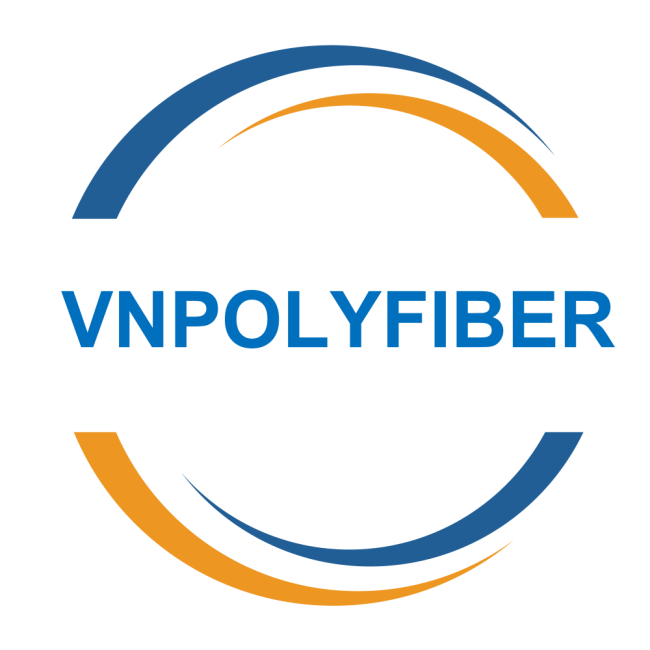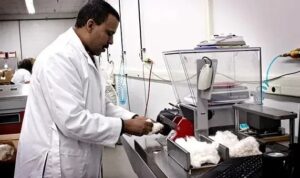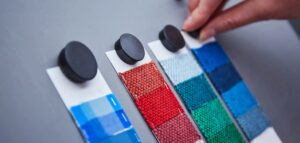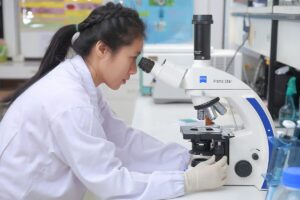Basic Understanding of Lyocell Fabric
Lyocell fabric represents a groundbreaking advancement in environmentally responsible textile production. The material transforms from wood to fabric in just two and a half hours and biodegrades completely within months. This stands in stark contrast to plastic-based materials that take up to 100 years to break down.
The innovative material shines with its closed-loop production process that recycles 99.5% of used solvents. Tencel lyocell fabric uses 20% less water than cotton while providing excellent moisture-wicking capabilities and durability.
This sustainable fabric has changed the textile industry with its versatile applications. The material works perfectly in clothing, bedding, and medical supplies. Its environmental benefits and practical advantages make it a true game-changer for manufacturers and consumers alike. This piece explains the production process, unique properties, and real-world applications of this revolutionary fabric.
What Is Tencel Lyocell Fabric?
Tencel lyocell fabric stands out as a breakthrough in textile development. This semi-synthetic fiber combines the best qualities of natural and synthetic materials. Wood pulp serves as its main ingredient, and its exceptional softness and performance have made it a popular choice in fashion and home textiles.
The difference between Tencel and lyocell
People often mix up “Tencel” and “lyocell,” but there’s an important difference. Lyocell is just the general name for this semi-synthetic fiber. Tencel, on the other hand, is a trademark that belongs to Lenzing AG, an Austrian company. You could say all Tencel is lyocell, but not all lyocell is Tencel. Products need at least 30% of Lenzing fibers to use the Tencel trademark.
The differences run deeper than just names. Lenzing’s version uses a closed-loop process that recycles more than 99% of chemicals. This makes it much better for the environment than regular lyocell. On top of that, it uses wood from certified sources that meet strict standards from the US Forest Steward Council or European Program for the Endorsement of Forest Certification.
Origins and development history
This fabric’s story started in 1972 at the American Enka fibers facility in North Carolina. The team there developed the manufacturing process, but the project didn’t go beyond pilot development. A British company, Courtaulds Fibers, picked up the research and made Tencel its trademark in 1982.
Courtaulds built their first small pilot plant in Coventry, England. It could make up to 100 kg of lyocell fiber weekly. Production grew steadily until 1992, when they reached full commercial production in Mobile, Alabama. Lenzing bought the Tencel Group in 2004 and became the world’s biggest lyocell fiber manufacturer.
How it compares to natural fibers
Lyocell sits between natural and synthetic materials. Though it starts as natural wood pulp, it needs processing to become the final fabric. In spite of that, it beats traditional natural fibers in several ways.
This fabric absorbs 50% more than cotton and wicks moisture better. It stays strong when wet, keeping 85% of its dry strength – way better than most natural options. People often describe it as softer and silkier than cotton, with an “airier” feel.
The environmental benefits are clear too. Making lyocell uses nowhere near as much water as growing cotton. The eucalyptus trees used in Tencel production grow fast without needing pesticides or heavy irrigation.
How Lyocell Fabric Is Made
The experience of creating lyocell fabric starts in managed forests and ends with silky-smooth textiles. The process is nowhere near as complex as traditional rayon production. Courtaulds developed this revolutionary method in 1992, which revolutionized wood-to-fabric manufacturing with impressive environmental credentials.
From tree to textile: the production process
The process begins when hardwood logs—typically eucalyptus, oak, or birch—are chipped into small pieces. These chips go through chemical digestion to remove lignin and hemicellulose. A bleaching process creates pure cellulose pulp that workers dry and roll onto spools.
The lyocell mill breaks down this pulp and dissolves it directly in N-methylmorpholine N-oxide (NMMO). This creates a viscous solution called “dope”. The process is simpler than rayon production because it doesn’t need chemical modification of the cellulose. After filtration, the solution goes through these steps:
- Extrusion through spinnerets (devices with thousands of tiny holes)
- Drawing through an air gap to arrange cellulose molecules for strength
- Immersion in a water bath where fibers solidify
- Washing to remove leftover solvent
The fibers dry, get lubricated, crimped, and carded before being cut and baled. The whole process takes about two hours from raw cellulose to finished fiber.
The closed-loop manufacturing system
The standout feature of lyocell production is its closed-loop system that recovers and reuses more than 99% of the NMMO solvent. This makes the process almost waste-free. NMMO is non-toxic, biodegradable and creates no harmful byproducts. This is a stark contrast to traditional viscose production that uses carbon disulfide and other toxic chemicals.
Why eucalyptus trees are commonly used
Tencel lyocell fabric manufacturers prefer eucalyptus because these trees grow faster with minimal water and pesticide needs. The trees thrive on land that’s unsuitable for food crops and capture carbon as they grow.
Lenzing, the company behind Tencel, gets its eucalyptus from FSC and PEFC certified forests. This ensures responsible management practices. The company bought 70,000 hectares in Brazil to establish certified eucalyptus plantations for environmentally responsible Tencel production.
Key Properties and Benefits of Lyocell
Lyocell fabric stands out not just for its eco-friendly production but also for its remarkable physical properties. These qualities have made it a top choice in fashion and functional textiles. The fabric’s unique molecular structure gives it performance features that are better than many traditional natural fibers.
Exceptional softness and comfort
Lyocell fabric feels as luxurious as silk or cashmere with its buttery-smooth texture against your skin. The microscopic structure creates a unique blend between fleece and satin. The fabric drapes beautifully on the body and gives clothes an elegant flow and silhouette. This incredible comfort makes lyocell a perfect choice for clothes that touch your skin directly, like underwear and baby clothes.
Moisture-wicking and breathability
Lyocell’s most impressive feature is how it handles moisture. The fabric can absorb 50% more moisture than regular cotton, which means it’s great at wicking away sweat and keeping your skin dry. These amazing properties come from the natural fibers and tiny pores that work together to absorb and release moisture efficiently.
The fabric creates a microclimate that helps control your body temperature. You’ll stay cool when it’s warm and comfortable when temperatures drop. These features are why lyocell has become so popular in activewear and summer clothing.
Durability and strength
Lyocell fabric combines luxury with incredible strength. It stays durable whether wet or dry and keeps much of its strength even when wet, unlike other fabrics. The fabric resists pilling and wrinkles really well, so it looks great even after many washes and regular wear.
Hypoallergenic qualities for sensitive skin
People with sensitive skin or conditions like atopic dermatitis love lyocell’s benefits. Research shows that people strongly prefer lyocell over cotton for sensitive skin. The naturally smooth surface reduces friction against your skin, which means less irritation and fewer flare-ups.
Lyocell’s breathable nature creates an environment where bacteria can’t thrive, so you won’t have to deal with unpleasant odors. This means you can wash your lyocell clothes less often, which saves water and helps them last longer.
Practical Uses of Tencel Lyocell Fabric
Tencel lyocell fabric has grown its presence in many sectors, from everyday clothing to specialized industrial applications, due to its exceptional performance characteristics. This innovative material’s versatility goes way beyond the reach and influence of simple textiles. Manufacturers continue to find new applications that leverage its unique properties.
Clothing applications
Lyocell fabric appears in everything from casual t-shirts to luxury garments in the fashion industry. The material shows its true value especially when you have activewear, where it absorbs 50% more moisture than cotton to provide superior comfort during physical activities. Lyocell’s hypoallergenic nature and silky smoothness create comfortable, irritation-free experiences in underwear and intimate apparel.
Designers now blend lyocell with cotton, polyester, and silk to improve strength and resilience. These composite fabrics are a big deal as it means that they’re stronger than their individual components. They offer improved durability without compromising comfort.
Bedding and home textiles
Lyocell fabric transforms home textiles into luxurious items that blend performance with comfort. Tencel sheets absorb 70% more moisture than cotton alternatives, which will give a drier, more comfortable sleep experience. These sheets stand out by maintaining their quality through more than 2,000 wash cycles without pilling.
Lyocell excels in pillows, comforters, and mattress pads. The expanded LENZING™ Lyocell Fill portfolio has specialized fibers in various densities and lengths. The portfolio features finer 1.7dtex variants for pillows and 6.7dtex for comforters and quilts, each engineered to meet specific comfort requirements.
Industrial and medical uses
Lyocell fabric’s exceptional strength makes it perfect for demanding industrial applications. Many manufacturers now use it in conveyor belts, where it lasts longer than traditional cotton components.
Healthcare settings have embraced lyocell for medical dressings, surgical gowns, and wound care products. Its hypoallergenic properties and high absorbency create medical textiles that work better, while naturally stopping bacterial growth.
Lyocell’s uniformity and strength make it an excellent choice for filtration products. Its structural integrity ensures consistent performance in critical applications.
Conclusion
Lyocell fabric is a breakthrough in eco-friendly textile manufacturing that offers major advantages over traditional materials. This versatile fabric delivers exceptional performance with strong environmental benefits thanks to its innovative closed-loop process.
Lyocell excels at moisture management and provides outstanding durability with natural comfort. These qualities make it perfect for products of all types – from everyday clothes to specialized medical supplies. The fabric uses 20% less water than cotton production and absorbs moisture 50% better, which makes it both environmentally responsible and superior in practice.
The future looks bright for lyocell as a key advancement in eco-friendly textile manufacturing. More consumers care about environmental impact now, and this biodegradable fabric shows how we can create high-performance materials that protect our planet’s future. The soaring win of Tencel lyocell proves that eco-friendly practices and superior product quality work well together.







